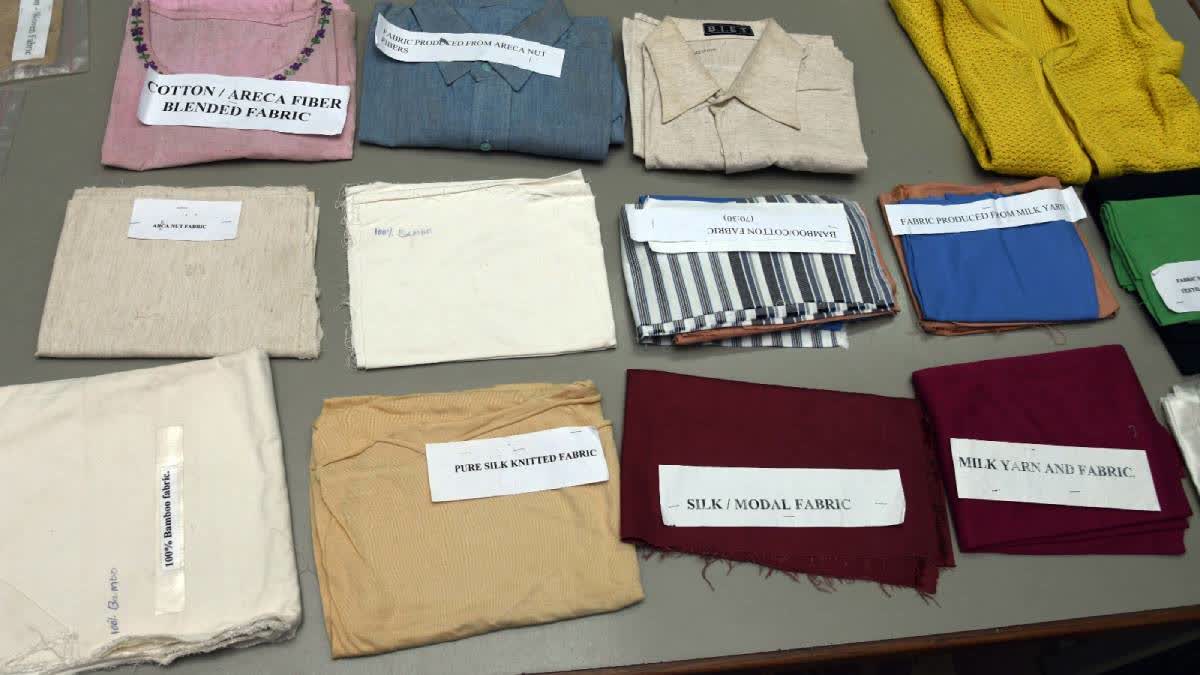Science
Students Transform Areca Nut Peels into Sustainable Products

Students from the Bapuji Institute of Engineering and Technology (BIET) in Davanagere, Karnataka, have successfully developed innovative products using waste peels from areca nuts. This initiative has reached an advanced stage after years of research and experimentation. The students have created garments such as shirts and women’s kurtas from the fiber extracted from the peels, showcasing a sustainable approach to textile production.
The project, supervised by HB Aravind, the principal of BIET, has also yielded surprising results in the form of sanitary pads made from areca nut peel composites. A total of 10 such pads have been produced as a part of this pioneering research. The textile technology department at BIET has made significant strides in utilizing areca fiber, alongside the creation of wooden sheets from spinnable waste materials.
Students and faculty, led by YN Dinesh, the head of the textile technology department, have invented a machine that efficiently extracts fiber from areca nut husks, converting them into usable yarn for fabric production. Since 2017, the team has prepared approximately 10,000 sanitary pads, distributing around 4,000 pads to local communities, which have provided positive feedback on their effectiveness.
As NS Manjunath, a biotechnology professor at BIET, explained, “Areca nut peels have no value. Hence, we have prepared sanitary pads from their fiber to use them for a good purpose.” The initiative has gained support from private companies, with plans to further enhance production capabilities. Currently, around six tonnes of areca nut peels are available, and the research team is encouraging local farmers to utilize these materials for sanitary pad production.
Farmers typically discard areca nut husks, considering them waste. The process begins by soaking the dried husks in water for three days, allowing the fiber to be separated and dried again. The fiber undergoes further processing in a blow room, where it is combed, sorted, and spun into yarn. To improve the texture of the fabric, the team blends 30% areca fiber with cotton yarn. Although the fabric made solely from areca fiber is somewhat coarse, this mixture aims to enhance softness while keeping production costs low.
Producing one meter of areca yarn costs approximately Rs 200, making it an economically viable option due to its zero-cost raw material status. The team acknowledges that efforts to soften the fabric further may increase production costs. Currently, the areca fiber fabrics being produced are soft and are being preserved for future use.
In addition to creating garments and sanitary products, the textile technology department has explored the potential of silk yarn. SM Chandrashekar, an associate professor in the department, highlighted the commercial value of areca nut as a crop, particularly in regions like Chitradurga, Tumkur, Mangalore, Shivamogga, and Davanagere. He emphasized the importance of utilizing peels that are typically discarded, as they can be transformed into valuable products.
The initiative at BIET may also contribute to revitalizing Davanagere, once known as the “cotton city” due to its flourishing cotton mills, now all closed. By harnessing local resources and promoting sustainable practices, BIET’s efforts could restore some of the city’s former industrial prominence.
As the project progresses, the research team remains focused on improving product quality and exploring additional applications, including diapers for children and bandages for medical use. The collaboration with local farmers and businesses presents an opportunity for economic growth and sustainability in the region.
-

 World4 months ago
World4 months agoSBI Announces QIP Floor Price at ₹811.05 Per Share
-

 Lifestyle4 months ago
Lifestyle4 months agoCept Unveils ₹3.1 Crore Urban Mobility Plan for Sustainable Growth
-

 Science4 months ago
Science4 months agoNew Blood Group Discovered in South Indian Woman at Rotary Centre
-

 World4 months ago
World4 months agoTorrential Rains Cause Flash Flooding in New York and New Jersey
-

 Sports4 months ago
Sports4 months agoBroad Advocates for Bowling Change Ahead of Final Test Against India
-

 Top Stories4 months ago
Top Stories4 months agoKonkani Cultural Organisation to Host Pearl Jubilee in Abu Dhabi
-

 Science4 months ago
Science4 months agoNothing Headphone 1 Review: A Bold Contender in Audio Design
-

 Top Stories4 months ago
Top Stories4 months agoAir India Crash Investigation Highlights Boeing Fuel Switch Concerns
-

 Sports4 months ago
Sports4 months agoCristian Totti Retires at 19: Pressure of Fame Takes Toll
-

 Business4 months ago
Business4 months agoIndian Stock Market Rebounds: Sensex and Nifty Rise After Four-Day Decline
-

 Politics4 months ago
Politics4 months agoAbandoned Doberman Finds New Home After Journey to Prague
-

 Top Stories4 months ago
Top Stories4 months agoPatna Bank Manager Abhishek Varun Found Dead in Well









